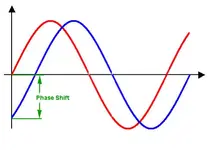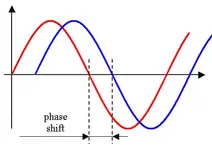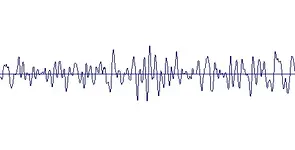That graph is a sin/cos function and is not phase shifting.
Well, to be fair, cosine is sine with a phase shift of pi/2 (cos(x) = sin(x + pi/2)).
And in that light, let me back myself up a minute and clarify; I was just as off as Wikiworld, but in a different way. They are indeed correct in their chart to indicate the phase shift as being along the x axis (x + amount of phase shift). I correct myself there.
However the point I intended to make remains true; that chart does NOT indicate a time shift. the x axis in that chart is not a timeline, it is simply a number line of math values for plugging into a mathematical equation to determine y value. The red line simply shows the y values for sin(x), and the blue line the y values for cos(x). Yes, phase shift is indicated, but that is only in mathematical value, not in any kind of time shift. This is why both lines start at x=0 (the left side of the chart).
Now, if you want to look at a time shift, as in a DAW timeline, then you have something like the second diagram I put up, which assumes that x is not a mathematical value, but rather just an elapsed timeline. Note the important difference here, the second line no longer starts at x=0, it's simply been pushed down a bit. Yes, this very closely resembles a phase shift, but it's not; it's simply a time delay. The captioned gap should be labeled "time shift", not "phase shift", because in fact the phase of the wave has not changed at all, it's just that it starts later than the first.
This is an important difference because it indicates a) that phase shift is calculated independent of any variable of time, and b) that phase shift indicates a change in y value coming out of the phase equation, not a change in x value going into it (this is what I was trying to indicate with the green caption on my first revision.)
Much like (but not exactly like) a phase change of 180° (a so-called "phase inversion") closely resembles a polarity inversion, but only as a special case (only at 180°, and only with no DC offset), a time shift resembles a phase shift, but only partially (only at x values where both waves exist), and only with symmetrical, frequency-bound waveforms (like sinusoidal waves).
Yes, if you time shift a copy of a time line and sum it back with the original, they will not be phase coherent. But that's not because you have changed the phase of the original wave, only because you have delayed the start of it. Change the phase of the wave is something that happens "in place", with no time shift involved.
For proof in example. Attached is a real-life waveform as taken from a Sound Forge timeline. Here's two problems for anyone to solve and be king of this forum. By simply shifting this waveform in time, a) change it's phase by 180°, and seperately, b) perform a phase inversion that resembles a polarity inversion.
Anybody that can do either one of those by time shifting is a cross somewhere between Albert Einstein and David Copperfield.

G.









